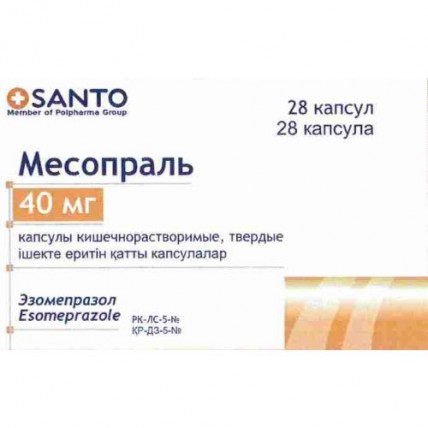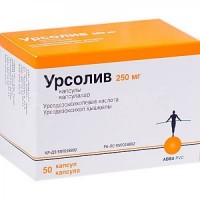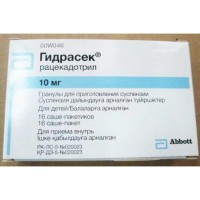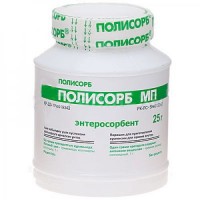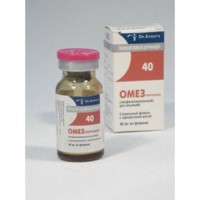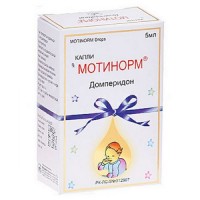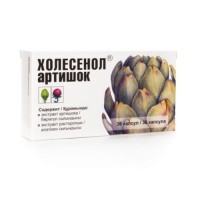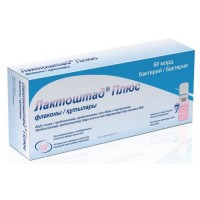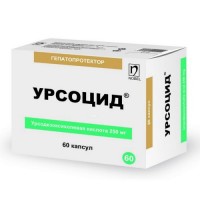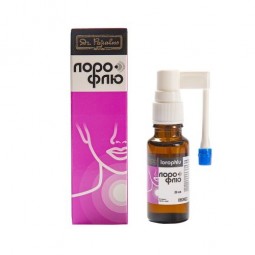Mesopral 40 mg capsules 28's
- $34.00
The instruction for medical use of Mesopral Torgovoye medicine a name Mesopral Mezhdunarodnoye the unlicensed name Esomeprazole Dosage Form of the Capsule kishechnorastvorimy, firm 20 mg and 40 mg Structure One capsule contains active agent - magnesium esomeprazole a dihydrate of 21.69 mg or 43.37 mg, in terms of esomeprazole of 20.0 mg and 40.0 mg, excipients: sugar spheres (sucrose, starch corn), a gipromelloza, dimetikon, polysorbate 80, Mannitolum, a monoglyceride diacetylized, talc, methacrylic acid and ethyl acrylate copolymer (1:1) dispersions of 30%, triethyl citrate, stearilmakrogolglitserida, the water purified. Structure of gelatin capsules body: gelatin, titan dioxide (E 171), gland (III) oxide yellow (E 172), ink black, lid: gelatin, the titan dioxide (E 171), gland (III) oxide yellow (E 172) the Description For a dosage of 20 mg. Solid gelatin capsules No. 4, the body – white opaque with an inscription black ink 20 mg, a lid – yellow opaque. Contents of capsules – spherical microgranules from almost white till grayish color. For a dosage of 40 mg. Solid gelatin capsules No. 3, the body – yellow opaque with an inscription black ink 40 mg, a lid – yellow opaque. Contents of capsules – spherical microgranules from almost white till grayish color. Pharmacotherapeutic group Antiulcerous drugs and drugs for treatment of a gastroesophageal reflux (GORD). Inhibitors of the protonew pump. Esomeprazole. The ATX A02BC05 code the Pharmacological Pharmacokinetics Esomeprazole properties is unstable in acidic environment and is accepted orally in the form of the granules covered with a kishechnorastvorimy cover. Absorption of esomeprazole happens quickly, the peak in blood plasma comes in 2 hours after reception. The absolute bioavailability is 64% after a single dose of 40 mg and increases up to 89% after repeated use of a single dose. For a dose of 20 mg of esomeprazole these values are 50% and 68%, respectively. Esomeprazole contacts proteins of plasma for 97%. Meal both detains, and reduces esomeprazole absorption though it has no significant effect on efficiency of inhibition of secretion of hydrochloric acid. Metabolism and removal Esomeprazole is completely metabolized with participation of a system of P450 cytochrome (CYP). The main part is metabolized with the participation of polymorphic CYP2C19 which is responsible for formation of hydroxy - and esomeprazole desmetilmetabolit. Metabolism of the rest depends on other specific isoform, CYP3A4 which is responsible for education sulphone esomeprazole - the main metabolite in blood plasma. The parameters specified below reflect, generally the nature of pharmacokinetics at patients with active CYP2C19 enzyme (at patients with extensive metabolism). The general plasma clearance is about 17 l/h after single dose of drug and 9 l/h – at repeated receptions. Elimination half-life makes 1.3 hours at repeated administrations of drug once a day. At intake of esomeprazole in a dose of 40 mg two times a day, the area under a curve concentration – time (AUC) increases at repeated administration of esomeprazole. This increase is dose-dependent and leads to more than dozoproportsionalny increase in AUC after repeated introduction. This time - and dozo-dependence is explained by decrease in metabolism at the first passing through a liver and also decrease in system clearance of esomeprazole that is probably connected with CYP2C19 enzyme inhibition esomeprazole and/or its sulfonsoderzhashy metabolite. Esomeprazole is completely removed from plasma between doses, at use once a day the tendency to cumulation of drug is not noted. The main metabolites of esomeprazole do not influence secretion of acid in a stomach. At oral administration up to 80% of a dose of drug other part is removed in the form of metabolites with urine, - with a stake. In urine less than 1% of not changed esomeprazole are found. Special category of patients Approximately at 2.9 ± 1.5% of the population the activity of CYP2C19 enzyme is reduced (patients with slow metabolism). Such patients have an esomeprazole metabolism, is generally carried out by means of CYP3A4. At repeated intake of 40 mg of esomeprazole once in day average area under a curve concentration – time is 100% higher, than at patients with active CYP2C19 enzyme (patients with fast metabolism). Average values of peak concentration in plasma at patients with slow metabolism are increased approximately by 60%. Noted features do not influence a dosage and a route of administration of esomeprazole. At patients of advanced age (71-80 years) the esomeprazole metabolism significantly does not change. After a single dose of esomeprazole in 40 mg, the average size of the area under a curve concentration – time is about 10% higher at women, than at men. After use of repeated single doses no sexual distinctions were observed. Noted features do not influence an esomeprazole dosage. At disturbances of functions of bodies At patients with slight and moderate abnormal liver functions the metabolism of esomeprazole can be slowed down. At patients with heavy abnormal liver functions the speed of metabolism is reduced that concentration – time for esomeprazole leads to doubling of the area under a curve. Therefore the maximum dose of esomeprazole for patients with heavy dysfunction of bodies makes 20 mg and it should not be exceeded. The tendency to cumulation of esomeprazole and its main metabolites at administration of drug is not noted once a day. Metabolism of esomeprazole is expected without any changes at patients with impaired renal function as kidneys are responsible for removal of metabolites of esomeprazole, but not the most initial substance. 12-18 summer patients have the general exposure (AUC) and time of achievement of the maximum concentration of drug in blood plasma (tmax) were similar to adults at reception of dosages of 20 mg and 40 mg of esomeprazole. The pharmacodynamics Esomeprazole is S-isomer of omeprazolum and reduces secretion of acid in a stomach by the specific aimed action mechanism. Drug represents inhibitor of the protonew pump in covering cells. S- and R-isomers of omeprazolum have similar pharmakodinamichesky activity. Esomeprazole is the weak basis, concentrates and passes into an active form in strongly acidic environment of secretory tubules of covering cells and inhibits H+, K enzyme +-ATFazu – the acid pump and inhibits both basal, and stimulated secretion of acid. Influence on secretion of acid in a stomach After oral administration of 20 mg or 40 mg of the drug Mesopral effect develops within 1 hour. At daily administration of drug within 5 days in a dose of 20 mg once a day, average peak concentration of acid after stimulation by Pentagastrinum decreases by 90%, at measurement of concentration of acid in 6-7 hours after reception of a dose for the 5th day of therapy. After 5 days of oral administration of esomeprazole in a dose of 20 mg and 40 mg, rn in a stomach was higher than 4 within, on average, 13 and 17 hours, respectively, more than 24 hours at patients with the symptomatic gastroesophageal reflux disease (GRD). After intake of esomeprazole in a dose of 20 mg, rn in a stomach was higher than 4 at 76% patients within 8 hours, at 54% of patients within 12 hours and at 24% of patients within 16 hours. The corresponding ratios for esomeprazole in a dose of 40 mg made 97%, 92% and 56%. Using the AUC parameter, as the replacing parameter for assessment of concentration of esomeprazole in plasma, the interrelation between secretion of acid and concentration of drug was revealed. The therapeutic effect reached acid secretion inhibition Healing a reflux esophagitis by the drug Mesopral in a dose of 40 mg is caused approximately at 78% of patients in 4 weeks and at 93% – in 8 weeks. The Mesopral drug treatment in a dose of 20 mg 2 times a day in a combination with the corresponding antibiotics within one week leads to Helicobacter pylori eradikation approximately at 90% of patients. In an uncomplicated ulcer of a duodenum the effective healing of an ulcer after a week eradikatsionny course does not require the subsequent monotherapy by anti-secretory drugs. Other effects connected with inhibition of secretion of acid during treatment by anti-secretory drugs gastrin level in plasma raises as a result of decrease in secretion of acid. At patients, the long time receiving esomeprazole, is noted increase in quantity of enterokhromaffinopodobny cells (ECL cells) probably connected with increase in level of gastrin in plasma. Esomeprazole showed high efficiency concerning healing of stomach ulcers and also prevention of stomach ulcers and a duodenum, at the patients receiving non-steroidal anti-inflammatory drugs (including at patients 60 years and/or with a round ulcer in the anamnesis are aged more senior), including selection inhibitors of cyclooxygenase-2 (TsOG-2). Indications Adult the Gastroesophageal Reflux Disease (GRD) - treatment erosive a reflux esophagitis - the long-term supporting treatment after healing erosive a reflux esophagitis for prevention of a recurrence - symptomatic treatment of a gastroesophageal reflux disease In a combination with the corresponding schemes of antibacterial treatment for Helicobacter pylori eradikation - for healing of an ulcer of the duodenum caused by Helicobacter pylori - for prevention of a recurrence of stomach ulcer and a duodenum in patients with the ulcer caused by Helicobacter pylori Patients who need long therapy by non-steroidal anti-inflammatory drugs (NPVP) - healing of the stomach ulcer connected with treatment of NPVP - prevention of the stomach ulcer and a duodenum caused by treatment of NPVP in patients of risk group Long kislotopodavlyayushchy therapy at the patients who had bleeding from a round ulcer (after intravenous use of the drugs lowering secretion of glands of a stomach for prevention of a recurrence) Treatment of a syndrome of Zollingera-Ellison Deti at the age of 12 years and are more senior the Gastroesophageal Reflux Disease (GRD) - treatment of erosion at a reflux esophagitis - prevention of a recurrence a reflux esophagitis - symptomatic treatment of a gastroesophageal reflux disease In a combination with the corresponding schemes of antibacterial treatment for Helicobacter pylori eradikation the Route of administration and doses of the Capsule should be swallowed entirely, washing down with a small amount of water. Capsules cannot be chewed or split up. For patients with difficulty when swallowing, capsules can be opened and to dissolve pellets in half of glass of still water. It is not necessary to use other liquids as the protective cover can be dissolved. To drink water with microgranules at once or within 30 minutes. Again to fill a glass with water half, to stir the remains and to drink. It is not necessary to chew or split up microgranules. Patients who cannot swallow capsules can open and dissolve pellets in still water, then to enter via the probe. It is important that the expediency of administration of drug by means of the syringe and a tube, was carefully considered. Adults and children since 12 years the Gastroesophageal reflux disease: on 40 mg once a day within 4 weeks. The additional 4-week course of treatment in cases when after the first course the healing of an esophagitis does not occur is recommended or symptoms remain. The long-term supporting treatment after healing erosive a reflux esophagitis for prevention of a recurrence: on 20 mg once a day. Symptomatic treatment of a gastroesophageal reflux disease: on 20 mg once a day – to patients without esophagitis. If after 4 weeks of treatment the symptoms do not disappear, it is necessary to perform additional examination of the patient. After elimination of symptoms of a disease it is possible to switch over to the mode of administration of drug if necessary, i.e. to accept Mesopral 20 mg once a day when resuming symptoms. For the patients accepting NPVP and belonging to risk group of development of stomach ulcer or a duodenum it is not recommended to prolong treatment in the mode if necessary. Adults as a part of combination therapy for Helicobacter pylori eradikation treatment of an ulcer of the duodenum associated with Helicobacter pylori: Mesopral of 20 mg, amoxicillin of 1 g and klaritromitsin 500 mg. All drugs are taken two times a day within 1 week. Long kislotopodavlyayushchy therapy at the patients who had bleeding from a round ulcer (after intravenous use of the drugs lowering secretion of glands of a stomach for prevention of a recurrence): on 40 mg once a day within 4 weeks after the end of intravenous therapy by the drugs lowering secretion of glands of a stomach. Patients who need continuous treatment of NPVP Healing of the stomach ulcer connected with reception of NPVP: usual dose of 20 mg once a day. Duration of treatment is 4-8 weeks. Prevention of the stomach ulcer and a duodenum tied with reception of NPVP at patients with risk: on 20 mg once a day. Long-term treatment after the intravenous induced prevention of a recurrence of bleeding from a round ulcer: on 40 mg once a day within 4 weeks after the intravenous induced prevention of a recurrence of bleeding from a round ulcer. Treatment of a syndrome of Zollingera-Ellison: the recommended initial dose of 40 mg two times a day. Then the dosage should be selected individually, duration of treatment is determined by a clinical picture of a disease. On the basis of clinical data, conditions of most of patients can be controlled receptions of doses from 80 to 160 mg of esomeprazole a day. At doses it is higher than 80 mg daily, it is necessary to divide and accept a dose two times a day. As a part of combination therapy for Helicobacter pylori eradikation treatment of an ulcer of the duodenum associated with Helicobacter pylori: Mesopral of 20 mg, amoxicillin of 1 g and klaritromitsin 500 mg. All drugs are taken two times a day within 1 week. Children at the age of 12 years are also more senior as a part of combination therapy for Helicobacter pylori eradikation treatment of an ulcer of the duodenum associated with Helicobacter pylori: Weight the Dosage of 30-40 kg In a combination with two antibiotics: 20 mg of esomeprazole, 750 mg of amoxicillin and 7.5 mg/kg of m of t. klaritromitsina. All drugs are used by 2 times a day within one week. & gt, 40 kg In a combination with two antibiotics: 20 mg of esomeprazole, 1 g of amoxicillin and 500 mg of a klaritromitsin. All drugs are used by 2 times a day within one week. To children 12 years are younger it is not necessary to appoint Mesopral due to the lack of data on safety. With impaired renal function the dose adjustment is not required from patients. Because of limited experience among patients with a heavy renal failure, it is necessary to be careful at treatment of such patients. With a slight and moderate liver failure the dose adjustment is not required from patients. For patients with a heavy liver failure, the maximum daily dose should not exceed 20 mg. Dose adjustment is not required from elderly patients. Administration of drug via nazogastralny probe 1. It is necessary to pour out capsule contents in the volume of 25 ml or 50 ml of water. In case of use of some types of probes, it is necessary to dissolve the capsule in 50 ml of water to avoid obstruction of the probe drug granules. To stir. 2. To gather a suspension in the syringe and to add about 5 ml of air. 3. To shake up the syringe within about 2 minutes for the purpose of distribution of granules in a suspension. 4. It is necessary to turn the syringe a tip up and to check whether there occurred obstruction of the syringe. 5. To connect tips of the probe and syringe, holding the syringe directed up. 6. It is necessary to stir up the syringe and to turn a tip down and at once to enter about 5-10 ml of a suspension into the probe. After introduction it is necessary to turn the syringe a tip up and to stir up (it is necessary to hold the syringe a tip up to avoid obstruction). 7. To turn the syringe a tip down and at once to enter 5-10 ml of a suspension into the probe. It is necessary to repeat this operation until the syringe is empty. 8. If it is necessary, it is necessary to fill the syringe of 25 ml of water and 5 ml of air and to repeat the operation described in item 6 to dilute a suspension deposit which can remain in the syringe. In case of use of some types of the probe
there can be necessary an addition of 50 ml of water. Side effects Often (& gt, 1/100, & lt, 1/10) - a headache - an abdominal pain, diarrhea, a meteorism, nausea, vomiting, a constipation Infrequently (& gt, 1/1000, & lt, 1/100) - dermatitis, an itching, urticaria, rash - dizziness - dryness in a mouth - insomnia, paresthesia, drowsiness - increase in activity of hepatic enzymes - peripheral hypostases - risk of developing spinal fractures, necks of a hip, a wrist is rare (& gt, 1/10000, & lt, 1/1000) - a leukopenia, thrombocytopenia - allergic reactions: fever, a Quincke's disease, anaphylactoid reaction / shock - excitement, a depression, an indisposition, confusion - disturbance of taste - a hyponatremia - a bronchospasm - stomatitis and gastrointestinal candidiasis - hepatitis with (or without) jaundice - a photosensitization, an alopecia - arthralgias, myalgias - illegibility of sight - perspiration Very seldom (& lt, 1/10000) - an agranulocytosis, a pancytopenia - hallucinations (mainly at the weakened patients), agressive behavior - a liver failure, hepatic encephalopathy - a multiformny erythema, Stephens-Johnson's syndrome, a toxic epidermal necrolysis - muscle weakness - interstitial nephrite - a gynecomastia Frequency is unknown - a gipomagneziyemiya, the heavy gipomagneziyemiya can lead to a hypocalcemia - microscopic colitis - a subacute skin lupus erythematosus of the Contraindication - hypersensitivity to esomeprazole, the substituted benzimidazoles or other components of drug - a concomitant use with nelfinaviry - pregnancy and the period of a lactation - children's and teenage age up to 12 years (the efficiency and safety is not studied) With care - a heavy renal failure Inhibitors of proteases it Is noted Medicinal interactions that omeprazolum reacts with some inhibitors of proteases. The clinical value and the mechanism of action, except the existing messages about such interaction, are not studied yet. Increase rn gastric juice during treatment by omeprazolum can influence absorption of inhibitors of proteases. Emergence of other interactions caused by oppression of action of an isoenzyme of CYP2C19 is possible. In case of purpose of an atazanavir and a nelfinavir the decrease in their concentration in plasma is noted during simultaneous use with omeprazolum therefore the combination of these drugs is not recommended. The combined use of omeprazolum (in a dose of 40 mg once a day) and an atazanavira in a dose of 300 mg / ritonavira in a dose of 100 mg at healthy volunteers led to decrease in exposure of an atazanavir (approximately for 75% reduction of AUC, Cmax and Cmin). Increase in a dose of an atazanavir up to 400 mg does not compensate influence of omeprazolum on exposure of an atazanavir. The combined use of omeprazolum (in a dose of 20 mg once a day) and an atazanavira in a dose of 400 mg and (or) led a ritonavir in a dose of 100 mg at healthy volunteers to decrease in exposure of an atazanavir (approximately for 30% in comparison with the exposure observed in case of an atazanavir of 300 mg and (or) a ritonavir of 100 mg once a day without omeprazolum on 20 mg once a day. The combined use of omeprazolum (in a dose of 40 mg once a day) leads to reduction of average exposure of a nelfinavir, Cmax and Cmin by 36‑39% and AUC, Cmax and Cmin for pharmacological active metabolite of M8 for 75-92%. Considering similar pharmakodinamichesky and pharmacokinetic properties of omeprazolum and esomeprazole, simultaneous use of esomeprazole and an atazanavir is not recommended, the combination of a nelfinavir with esomeprazole is contraindicated. In case of the sakvinavir (applied with ritonaviry) the increase in its concentration in blood (80-100%) at simultaneous use of omeprazolum is noted (40 mg once a day). Use of omeprazolum in a dose of 20 mg did not influence exposure of a darunavir (with a concomitant use of a ritonavir) and an amprenavira (a combination with ritonaviry). Use of omeprazolum in a dose of 20 mg a day did not influence exposure of an amprenavir (with a concomitant use of a ritonavir or without it). Use of omeprazolum in a dose of 40 mg a day did not influence exposure of a lopinavir (with a concomitant use of a ritonavir). The methotrexate At joint reception of IPP and methotrexate, is noted increase in concentration at some patients. At use of a methotrexate in high doses it is necessary to suspend intake of esomeprazole. Takrolimus Joint appointment with esomeprazole led to increase in concentration of a takrolimus in serum. Can lead medicines which absorption depends on value rn Suppression of acidity of gastric juice against the background of treatment by esomeprazole and other inhibitors of a proton pomp to change of absorption of drugs which absorption depends on acidity of the environment. Esomeprazole, as well as other means reducing secretion of acid in a stomach can lead to decrease in absorption of a ketokonazol, itrakonazol and erlotinib. At the same time at joint intake of esomeprazole with digoxin, concentration of the last can increase. The active ingredients biotransformed by CYP2C19 Esomeprazole are inhibited by CYP2C19 - the main enzyme participating in his metabolism. Respectively, combined use of esomeprazole with other drugs in which metabolism CYP2C19, such as diazepam, to tsitalopra, Imipraminum, klomipramin, Phenytoinum, etc. takes part can lead to increase in concentration of these drugs in plasma that, in turn, can demand a dose decline. It is especially important to remember this interaction when prescribing the drug Mesopral in the mode as necessary. Diazepam At joint reception of 30 mg of esomeprazole and diazepam which is CYP2C19 cytochrome substrate, is noted decrease in clearance of diazepam by 45%. Prescribing of esomeprazole in a dose of 40 mg led Phenytoinum to increase in residual concentration of Phenytoinum at patients with epilepsy for 13%. In this regard it is recommended to control concentration of Phenytoinum in plasma in an initiation of treatment esomeprazole and at its cancellation. Vorikonazol Simultaneous use of omeprazolum (40 mg once a day) and a vorikonazola (substrate for CYP2C19) increased Cmax and AUCτ respectively by 15% and 41%. Tsilostazol Omeprazol and also esomeprazole have the effect inhibiting CYP2C19. Use of omeprazolum for healthy volunteers in doses of 40 mg in a research with the cross scheme of a dosage increased Cmax and AUC of a tsilostazol respectively by 18% and for 26%, and one of the main metabolites respectively for 29% and 69%. Tsizaprid leads Joint reception of a tsizaprid from 40 mg of esomeprazole to increase in values of pharmacokinetic parameters of a tsizaprid at healthy volunteers: AUC - for 32% and elimination half-life for 31%, however the maximum concentration of a tsizaprid in plasma at the same time considerably does not change. Insignificant lengthening of an interval of QT which was observed at monotherapy tsizapridy at addition of esomeprazole did not increase. Warfarin does not lead Joint intake of warfarin from 40 mg of esomeprazole to change of time of coagulation at patients, is long accepting warfarin. However it was reported about several cases of clinically significant increase in the INR (the international normalized relation) index at combined use of warfarin and esomeprazole. Therefore at the beginning and upon termination of combined use of these drugs it is recommended to control MNO. Klopidogrel by results of researches at healthy volunteers it is noted pharmacokinetic / pharmakodinamicheskoye interaction between klopidogrely (a load dose of 300 mg / a daily maintenance dose of 75 mg) and esomeprazole (40 mg a day inside), leading to decrease in exposure of an active metabolite klopidogret on average for 40% and leading to decrease in the maximum inhibition caused by ADF of aggregation of thrombocytes on average for 14%. In clinical trial at healthy volunteers the decrease in exposure of an active metabolite of a klopidogrel almost by 40% at simultaneous use of constant doses of esomeprazole of 20 mg and acetylsalicylic acid (ASA) of 81 mg also in combination with klopidogrely is noted, in comparison with exposure only klopidogret. These patients had maximum inhibition ADF-indutsirovannoy of aggregation of thrombocytes the same in both groups. Results of clinical effects this pharmacokinetic / pharmakodinamicheskogo the interactions of rather serious cardiovascular violations proceeding from observation and clinical trials are ambiguous. Considering safety of pharmacotherapy it is not necessary to apply esomeprazole in combination with klopidogrely. Amoxicillin and Ezomeprazol quinidine does not cause clinically significant changes of pharmacokinetics of amoxicillin and quinidine. Naproxenum or rofekoksib Researches on assessment of short-term combined use of esomeprazole and Naproxenum or a rofekoksib did not reveal clinically significant pharmacokinetic interaction. Influence of other medicines on pharmacokinetic properties of esomeprazole Esomeprazole is metabolized by CYP2C19 and CYP3A4. The accompanying use of esomeprazole and such CYP3A4 inhibitor as klaritromitsin (500 mg, two times a day), leads to doubling of exposure (AUC) of esomeprazole. Combined use of esomeprazole and the combined CYP2C19 and CYP3A4 inhibitor can lead to increase in exposure of esomeprazole more than twice. Vorikonazol (CYP2C19 and CYP3A4 inhibitor) increased AUCτ by 280%. In similar situations of dose adjustment of esomeprazole usually it is not required. Nevertheless, the possibility of dose adjustment should be considered at patients with a heavy liver failure and at long-term treatment. The drugs inducing CYP2C19 or CYP3A4 or both cytochromes (for example rifampicin and a St. John's wort), can lead to increase in serumal levels of esomeprazole by means of increase in his metabolism. Special instructions in the presence of any disturbing symptoms (for example, such as considerable spontaneous loss of body weight, repeated vomiting, a dysphagy, vomiting with impurity of blood or a melena) and also in the presence of stomach ulcer (or at suspicion of stomach ulcer) it is necessary to exclude existence of a malignant new growth as the Mesopral drug treatment can lead to smoothing of symptomatology and delay diagnosis. The patients taking the drug during the long period (especially over a year) have to be under regular observation of the doctor. The patients accepting Mesopral as necessary have to be instructed about need to contact the doctor at change of nature of symptoms. In view of fluctuations of concentration of esomeprazole in plasma when assigning therapy as necessary, it is necessary to consider interaction of drug with other medicines. When prescribing the drug Mesopral for an eradikation of Helicobacter pylori the possibility of medicinal interactions for all components of triple therapy has to be considered. Klaritromitsin is powerful CYP3A4 inhibitor therefore when assigning eradikatsionny therapy the patients receiving other drugs which are metabolized with participation of CYP3A4 (for example, a tsisaprida) need to consider possible contraindications and interactions of a klaritromitsin with these medicines. Treatment by inhibitors of a proton pomp can lead to insignificant increase in risk of developing of the gastrointestinal infections caused by Salmonella and Campylobacter. Mesopral, as well as all drugs blocking acid secretion can reduce B12 vitamin absorption (cyanocobalamin) owing to hypo - or achlorhydrias. It should be taken into account at patients with reduced reserves of B12 vitamin in an organism or with risk factors of decrease in absorption of B12 at long-term therapy. The heavy hypomagnesiemia was observed at the patients receiving treatment by such inhibitors of the proton pump (IPP) as esomeprazole within not less than three months and in most cases at use within a year. There can be such serious manifestations of a hypomagnesiemia as exhaustion, a tetany, a delirium, convulsions, dizziness and ventricular arrhythmia, but they can suddenly begin and it is heavy to reveal them. At most of patients, the hypomagnesiemia decreases after replacement magnesian therapy and the termination of treatment of IPP. At patients at whom long treatment is supposed or which accept IPP with the digoxin or drugs capable to cause a hypomagnesiemia (for example, diuretics) it is necessary to measure magnesium levels prior to therapy of IPP and periodically during treatment. Inhibitors of the proton pump, especially at their use in high doses and for an appreciable length of time (more than 1 year), can moderately increase risk of a fracture of hip joint, wrist or backbone, generally at elderly patients or in the presence of other recognized risk factors. Observation researches allow to assume that inhibitors of the proton pump can increase the general risk of changes by 10-40%. Patients with the increased risk of osteoporosis have to be observed and treated according to the current clinical recommendations, and also accept adequate amount of vitamin D and calcium. Use of the inhibitors of the proton pump (IPP) is associated with very exceptional cases of development of the subacute skin lupus erythematosus (SSLE). If there is a damage of skin, especially on the sites opened to sunlight, together with an arthralgia, then the patient has to ask in due time for medical care, and the doctor has to consider the decision on drug withdrawal Mesopral. PKKV at treatment of IPN in the anamnesis can increase risk of development of PKKV at use of other IPN. Influence on the laboratory researches Increase in the CgA Level can affect researches of neuroendocrinal tumors. To avoid this influence, esomeprazole it is necessary to stop treatment temporarily not less than in 5 days prior to measurement of CgA. Mesopral contains sucrose. Patients with hereditary intolerance of fructose, glyukozo-galaktozny malabsorption or sakharazo-izomaltazny insufficiency should not take this drug. Mesopral contains parahydroxybenzoates which can cause allergic reactions (reactions of late type are possible). Pregnancy and a lactation Clinical data on influence of esomeprazole at pregnancy are insufficient. It is necessary to appoint drug pregnant only when the expected advantage for mother exceeds possible risk for a fruit. It is unknown whether esomeprazole with breast milk is emitted therefore it is not necessary to appoint Mesopral during feeding a breast. Features of influence of medicine on ability to run the vehicle or potentially dangerous mechanisms Considering side effects of medicine, it is necessary to be careful when driving or potentially dangerous mechanisms. Simtoma's overdose: the general weakness strengthening of side effects, including from digestive tract. Treatment: the symptomatic and supporting treatment. Dialysis is ineffective. Specific antidotes are unknown. A form of release and packing On 7 capsules in blister strip packaging from a film polyvinylchloride (an inside layer polyvinylchloride/aluminium / a polyamide film) and aluminum foil. On the 4th blister strip packagings together with utverzh
to Develop
there can be necessary an addition of 50 ml of water. Side effects Often (& gt, 1/100, & lt, 1/10) - a headache - an abdominal pain, diarrhea, a meteorism, nausea, vomiting, a constipation Infrequently (& gt, 1/1000, & lt, 1/100) - dermatitis, an itching, urticaria, rash - dizziness - dryness in a mouth - insomnia, paresthesia, drowsiness - increase in activity of hepatic enzymes - peripheral hypostases - risk of developing spinal fractures, necks of a hip, a wrist is rare (& gt, 1/10000, & lt, 1/1000) - a leukopenia, thrombocytopenia - allergic reactions: fever, a Quincke's disease, anaphylactoid reaction / shock - excitement, a depression, an indisposition, confusion - disturbance of taste - a hyponatremia - a bronchospasm - stomatitis and gastrointestinal candidiasis - hepatitis with (or without) jaundice - a photosensitization, an alopecia - arthralgias, myalgias - illegibility of sight - perspiration Very seldom (& lt, 1/10000) - an agranulocytosis, a pancytopenia - hallucinations (mainly at the weakened patients), agressive behavior - a liver failure, hepatic encephalopathy - a multiformny erythema, Stephens-Johnson's syndrome, a toxic epidermal necrolysis - muscle weakness - interstitial nephrite - a gynecomastia Frequency is unknown - a gipomagneziyemiya, the heavy gipomagneziyemiya can lead to a hypocalcemia - microscopic colitis - a subacute skin lupus erythematosus of the Contraindication - hypersensitivity to esomeprazole, the substituted benzimidazoles or other components of drug - a concomitant use with nelfinaviry - pregnancy and the period of a lactation - children's and teenage age up to 12 years (the efficiency and safety is not studied) With care - a heavy renal failure Inhibitors of proteases it Is noted Medicinal interactions that omeprazolum reacts with some inhibitors of proteases. The clinical value and the mechanism of action, except the existing messages about such interaction, are not studied yet. Increase rn gastric juice during treatment by omeprazolum can influence absorption of inhibitors of proteases. Emergence of other interactions caused by oppression of action of an isoenzyme of CYP2C19 is possible. In case of purpose of an atazanavir and a nelfinavir the decrease in their concentration in plasma is noted during simultaneous use with omeprazolum therefore the combination of these drugs is not recommended. The combined use of omeprazolum (in a dose of 40 mg once a day) and an atazanavira in a dose of 300 mg / ritonavira in a dose of 100 mg at healthy volunteers led to decrease in exposure of an atazanavir (approximately for 75% reduction of AUC, Cmax and Cmin). Increase in a dose of an atazanavir up to 400 mg does not compensate influence of omeprazolum on exposure of an atazanavir. The combined use of omeprazolum (in a dose of 20 mg once a day) and an atazanavira in a dose of 400 mg and (or) led a ritonavir in a dose of 100 mg at healthy volunteers to decrease in exposure of an atazanavir (approximately for 30% in comparison with the exposure observed in case of an atazanavir of 300 mg and (or) a ritonavir of 100 mg once a day without omeprazolum on 20 mg once a day. The combined use of omeprazolum (in a dose of 40 mg once a day) leads to reduction of average exposure of a nelfinavir, Cmax and Cmin by 36‑39% and AUC, Cmax and Cmin for pharmacological active metabolite of M8 for 75-92%. Considering similar pharmakodinamichesky and pharmacokinetic properties of omeprazolum and esomeprazole, simultaneous use of esomeprazole and an atazanavir is not recommended, the combination of a nelfinavir with esomeprazole is contraindicated. In case of the sakvinavir (applied with ritonaviry) the increase in its concentration in blood (80-100%) at simultaneous use of omeprazolum is noted (40 mg once a day). Use of omeprazolum in a dose of 20 mg did not influence exposure of a darunavir (with a concomitant use of a ritonavir) and an amprenavira (a combination with ritonaviry). Use of omeprazolum in a dose of 20 mg a day did not influence exposure of an amprenavir (with a concomitant use of a ritonavir or without it). Use of omeprazolum in a dose of 40 mg a day did not influence exposure of a lopinavir (with a concomitant use of a ritonavir). The methotrexate At joint reception of IPP and methotrexate, is noted increase in concentration at some patients. At use of a methotrexate in high doses it is necessary to suspend intake of esomeprazole. Takrolimus Joint appointment with esomeprazole led to increase in concentration of a takrolimus in serum. Can lead medicines which absorption depends on value rn Suppression of acidity of gastric juice against the background of treatment by esomeprazole and other inhibitors of a proton pomp to change of absorption of drugs which absorption depends on acidity of the environment. Esomeprazole, as well as other means reducing secretion of acid in a stomach can lead to decrease in absorption of a ketokonazol, itrakonazol and erlotinib. At the same time at joint intake of esomeprazole with digoxin, concentration of the last can increase. The active ingredients biotransformed by CYP2C19 Esomeprazole are inhibited by CYP2C19 - the main enzyme participating in his metabolism. Respectively, combined use of esomeprazole with other drugs in which metabolism CYP2C19, such as diazepam, to tsitalopra, Imipraminum, klomipramin, Phenytoinum, etc. takes part can lead to increase in concentration of these drugs in plasma that, in turn, can demand a dose decline. It is especially important to remember this interaction when prescribing the drug Mesopral in the mode as necessary. Diazepam At joint reception of 30 mg of esomeprazole and diazepam which is CYP2C19 cytochrome substrate, is noted decrease in clearance of diazepam by 45%. Prescribing of esomeprazole in a dose of 40 mg led Phenytoinum to increase in residual concentration of Phenytoinum at patients with epilepsy for 13%. In this regard it is recommended to control concentration of Phenytoinum in plasma in an initiation of treatment esomeprazole and at its cancellation. Vorikonazol Simultaneous use of omeprazolum (40 mg once a day) and a vorikonazola (substrate for CYP2C19) increased Cmax and AUCτ respectively by 15% and 41%. Tsilostazol Omeprazol and also esomeprazole have the effect inhibiting CYP2C19. Use of omeprazolum for healthy volunteers in doses of 40 mg in a research with the cross scheme of a dosage increased Cmax and AUC of a tsilostazol respectively by 18% and for 26%, and one of the main metabolites respectively for 29% and 69%. Tsizaprid leads Joint reception of a tsizaprid from 40 mg of esomeprazole to increase in values of pharmacokinetic parameters of a tsizaprid at healthy volunteers: AUC - for 32% and elimination half-life for 31%, however the maximum concentration of a tsizaprid in plasma at the same time considerably does not change. Insignificant lengthening of an interval of QT which was observed at monotherapy tsizapridy at addition of esomeprazole did not increase. Warfarin does not lead Joint intake of warfarin from 40 mg of esomeprazole to change of time of coagulation at patients, is long accepting warfarin. However it was reported about several cases of clinically significant increase in the INR (the international normalized relation) index at combined use of warfarin and esomeprazole. Therefore at the beginning and upon termination of combined use of these drugs it is recommended to control MNO. Klopidogrel by results of researches at healthy volunteers it is noted pharmacokinetic / pharmakodinamicheskoye interaction between klopidogrely (a load dose of 300 mg / a daily maintenance dose of 75 mg) and esomeprazole (40 mg a day inside), leading to decrease in exposure of an active metabolite klopidogret on average for 40% and leading to decrease in the maximum inhibition caused by ADF of aggregation of thrombocytes on average for 14%. In clinical trial at healthy volunteers the decrease in exposure of an active metabolite of a klopidogrel almost by 40% at simultaneous use of constant doses of esomeprazole of 20 mg and acetylsalicylic acid (ASA) of 81 mg also in combination with klopidogrely is noted, in comparison with exposure only klopidogret. These patients had maximum inhibition ADF-indutsirovannoy of aggregation of thrombocytes the same in both groups. Results of clinical effects this pharmacokinetic / pharmakodinamicheskogo the interactions of rather serious cardiovascular violations proceeding from observation and clinical trials are ambiguous. Considering safety of pharmacotherapy it is not necessary to apply esomeprazole in combination with klopidogrely. Amoxicillin and Ezomeprazol quinidine does not cause clinically significant changes of pharmacokinetics of amoxicillin and quinidine. Naproxenum or rofekoksib Researches on assessment of short-term combined use of esomeprazole and Naproxenum or a rofekoksib did not reveal clinically significant pharmacokinetic interaction. Influence of other medicines on pharmacokinetic properties of esomeprazole Esomeprazole is metabolized by CYP2C19 and CYP3A4. The accompanying use of esomeprazole and such CYP3A4 inhibitor as klaritromitsin (500 mg, two times a day), leads to doubling of exposure (AUC) of esomeprazole. Combined use of esomeprazole and the combined CYP2C19 and CYP3A4 inhibitor can lead to increase in exposure of esomeprazole more than twice. Vorikonazol (CYP2C19 and CYP3A4 inhibitor) increased AUCτ by 280%. In similar situations of dose adjustment of esomeprazole usually it is not required. Nevertheless, the possibility of dose adjustment should be considered at patients with a heavy liver failure and at long-term treatment. The drugs inducing CYP2C19 or CYP3A4 or both cytochromes (for example rifampicin and a St. John's wort), can lead to increase in serumal levels of esomeprazole by means of increase in his metabolism. Special instructions in the presence of any disturbing symptoms (for example, such as considerable spontaneous loss of body weight, repeated vomiting, a dysphagy, vomiting with impurity of blood or a melena) and also in the presence of stomach ulcer (or at suspicion of stomach ulcer) it is necessary to exclude existence of a malignant new growth as the Mesopral drug treatment can lead to smoothing of symptomatology and delay diagnosis. The patients taking the drug during the long period (especially over a year) have to be under regular observation of the doctor. The patients accepting Mesopral as necessary have to be instructed about need to contact the doctor at change of nature of symptoms. In view of fluctuations of concentration of esomeprazole in plasma when assigning therapy as necessary, it is necessary to consider interaction of drug with other medicines. When prescribing the drug Mesopral for an eradikation of Helicobacter pylori the possibility of medicinal interactions for all components of triple therapy has to be considered. Klaritromitsin is powerful CYP3A4 inhibitor therefore when assigning eradikatsionny therapy the patients receiving other drugs which are metabolized with participation of CYP3A4 (for example, a tsisaprida) need to consider possible contraindications and interactions of a klaritromitsin with these medicines. Treatment by inhibitors of a proton pomp can lead to insignificant increase in risk of developing of the gastrointestinal infections caused by Salmonella and Campylobacter. Mesopral, as well as all drugs blocking acid secretion can reduce B12 vitamin absorption (cyanocobalamin) owing to hypo - or achlorhydrias. It should be taken into account at patients with reduced reserves of B12 vitamin in an organism or with risk factors of decrease in absorption of B12 at long-term therapy. The heavy hypomagnesiemia was observed at the patients receiving treatment by such inhibitors of the proton pump (IPP) as esomeprazole within not less than three months and in most cases at use within a year. There can be such serious manifestations of a hypomagnesiemia as exhaustion, a tetany, a delirium, convulsions, dizziness and ventricular arrhythmia, but they can suddenly begin and it is heavy to reveal them. At most of patients, the hypomagnesiemia decreases after replacement magnesian therapy and the termination of treatment of IPP. At patients at whom long treatment is supposed or which accept IPP with the digoxin or drugs capable to cause a hypomagnesiemia (for example, diuretics) it is necessary to measure magnesium levels prior to therapy of IPP and periodically during treatment. Inhibitors of the proton pump, especially at their use in high doses and for an appreciable length of time (more than 1 year), can moderately increase risk of a fracture of hip joint, wrist or backbone, generally at elderly patients or in the presence of other recognized risk factors. Observation researches allow to assume that inhibitors of the proton pump can increase the general risk of changes by 10-40%. Patients with the increased risk of osteoporosis have to be observed and treated according to the current clinical recommendations, and also accept adequate amount of vitamin D and calcium. Use of the inhibitors of the proton pump (IPP) is associated with very exceptional cases of development of the subacute skin lupus erythematosus (SSLE). If there is a damage of skin, especially on the sites opened to sunlight, together with an arthralgia, then the patient has to ask in due time for medical care, and the doctor has to consider the decision on drug withdrawal Mesopral. PKKV at treatment of IPN in the anamnesis can increase risk of development of PKKV at use of other IPN. Influence on the laboratory researches Increase in the CgA Level can affect researches of neuroendocrinal tumors. To avoid this influence, esomeprazole it is necessary to stop treatment temporarily not less than in 5 days prior to measurement of CgA. Mesopral contains sucrose. Patients with hereditary intolerance of fructose, glyukozo-galaktozny malabsorption or sakharazo-izomaltazny insufficiency should not take this drug. Mesopral contains parahydroxybenzoates which can cause allergic reactions (reactions of late type are possible). Pregnancy and a lactation Clinical data on influence of esomeprazole at pregnancy are insufficient. It is necessary to appoint drug pregnant only when the expected advantage for mother exceeds possible risk for a fruit. It is unknown whether esomeprazole with breast milk is emitted therefore it is not necessary to appoint Mesopral during feeding a breast. Features of influence of medicine on ability to run the vehicle or potentially dangerous mechanisms Considering side effects of medicine, it is necessary to be careful when driving or potentially dangerous mechanisms. Simtoma's overdose: the general weakness strengthening of side effects, including from digestive tract. Treatment: the symptomatic and supporting treatment. Dialysis is ineffective. Specific antidotes are unknown. A form of release and packing On 7 capsules in blister strip packaging from a film polyvinylchloride (an inside layer polyvinylchloride/aluminium / a polyamide film) and aluminum foil. On the 4th blister strip packagings together with utverzh
to Develop
